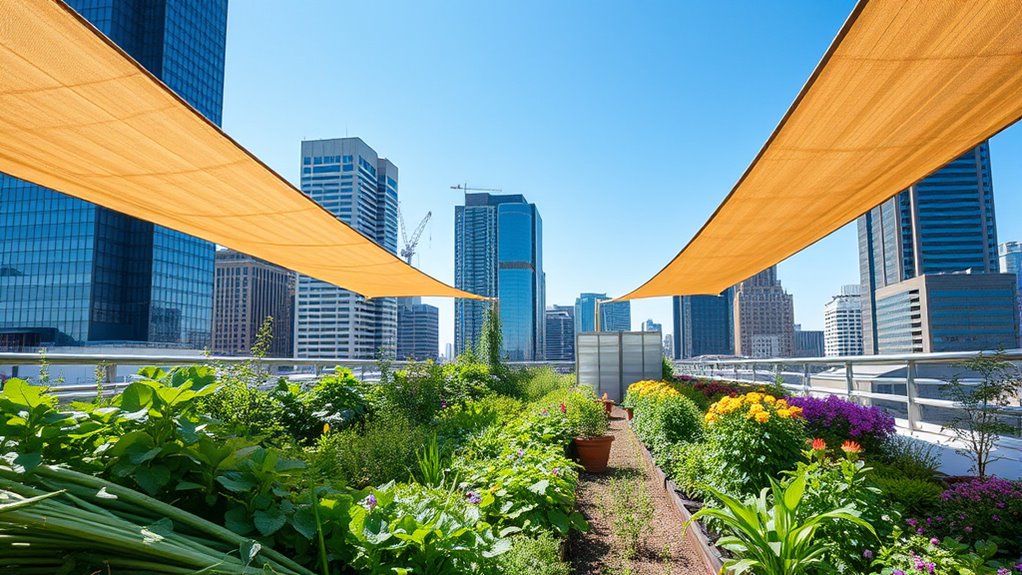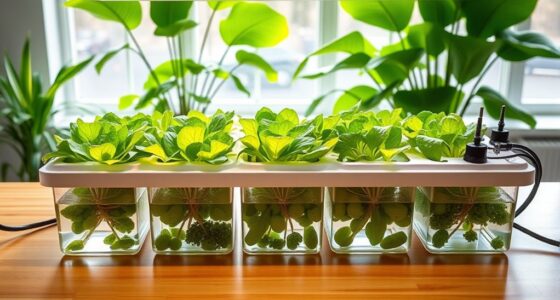To embrace sustainable gardening in the city, choose native, low-maintenance plants suited to your space and light conditions, and use container-friendly options for smaller areas. Conserve water with drip irrigation, mulching, and rainwater harvesting. Enrich your soil naturally through composting with kitchen scraps, yard waste, and organic amendments. Manage pests with beneficial insects and companion planting, and design community spaces that promote biodiversity and shared resources. Keep exploring these practices to transform your urban garden into an eco-friendly oasis.
Key Takeaways
- Choose native, low-maintenance plants suited for urban environments to reduce water and resource use.
- Implement water-saving techniques like drip irrigation, mulching, and rainwater harvesting to conserve water.
- Enrich soil with organic compost and amendments, and practice cover cropping to promote soil health sustainably.
- Manage pests naturally using beneficial insects, organic sprays, and companion planting to minimize chemical interventions.
- Design community-oriented gardens with reclaimed materials, vertical layers, and shared resources to enhance sustainability and social engagement.
Choosing the Right Plants for Urban Spaces
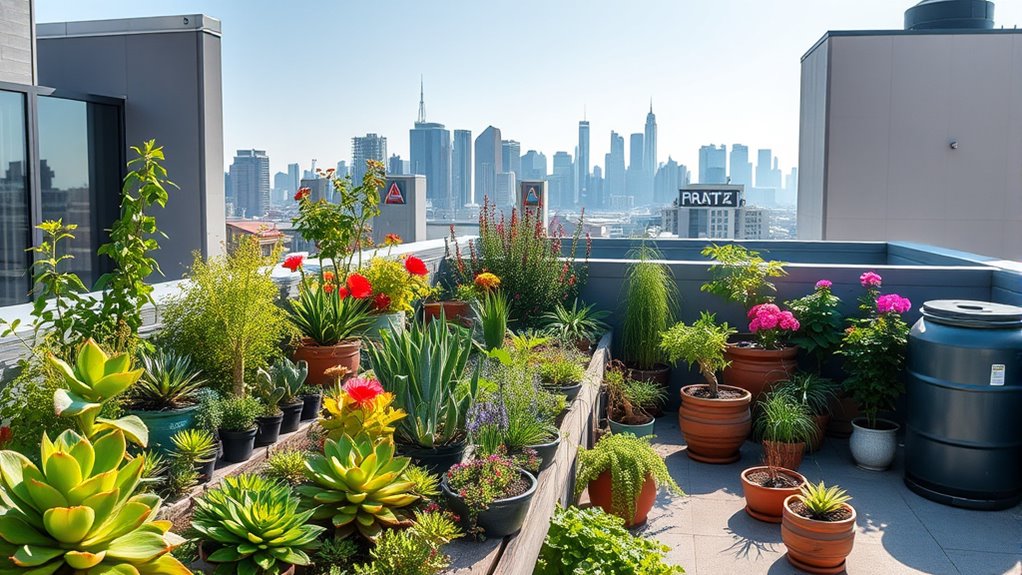
Have you considered how selecting the right plants can make urban gardening more sustainable? Your plant selection plays a key role in creating a thriving green space in urban environments. Native plants are ideal because they require less water, fertilizer, and maintenance, supporting sustainable urban gardening. For small-space gardening, container-friendly plants like herbs, lettuce, and compact tomatoes fit perfectly on balconies or windowsills, maximizing limited space. Matching plants to indoor lighting—full sun, partial shade, or low light—ensures healthy plant growth with minimal resources. Incorporating low-maintenance plants such as succulents, snake plants, or pothos helps keep your indoor garden vibrant and manageable. Choosing the right plants can also help minimize environmental impact by reducing resource consumption and aligning with ecological considerations.
Implementing Water-Efficient Gardening Techniques

Implementing water-efficient gardening techniques is essential for creating sustainable urban green spaces. You can start by installing drip irrigation systems, which cut water use by up to 90%. Mulching around plants helps conserve soil moisture, reducing the need for frequent plant watering by about 50%. Proper planning and intelligence gathering can help identify the most efficient watering schedules and drought-tolerant plant selections for your area. Using rainwater harvesting barrels supplies up to 60% of your garden’s water needs, lowering reliance on municipal sources. Soil moisture meters ensure you only water when necessary, preventing overwatering and promoting water conservation. Incorporate drought-tolerant plants suited for urban gardening to further reduce water consumption. Choosing efficient watering systems and practicing water efficiency will help you maintain a healthy, sustainable garden while conserving valuable water resources.
Maintaining Healthy Soil and Composting Methods
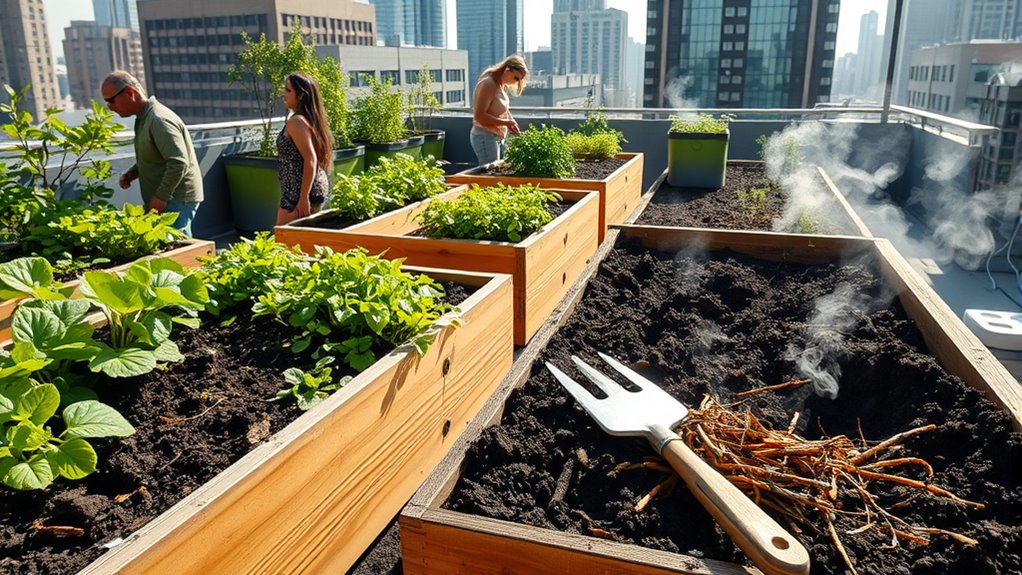
Building on water-saving techniques, maintaining healthy soil is crucial for sustainable urban gardening. Composting kitchen scraps, yard waste, and leaves reduces landfill waste and boosts soil nutrients. Using organic amendments like aged manure, compost, and biochar enhances soil fertility and structure. Regular soil testing helps you monitor pH and detect contaminants, guaranteeing safe urban gardening. Incorporating soil testing methods into your routine can further improve your garden management. Cover cropping and mulching conserve moisture, suppress weeds, and promote beneficial soil microbiota. Additionally, implementing soil health practices supports long-term soil vitality and productivity. For example, incorporating soil amendments such as organic matter improves soil texture and nutrient availability. Understanding the cost of electric bike options available can motivate urban gardeners to explore eco-friendly transportation for community gardening projects. Incorporate the following strategies:
| Practice | Benefits | Tips |
|---|---|---|
| Composting | Enriches soil with essential nutrients | Mix kitchen scraps and yard waste |
| Organic amendments | Improve soil structure and fertility | Use biochar or aged manure |
| Cover cropping | Protects soil and supports microbiota | Plant during off-season |
| Soil testing | Ensures proper nutrient management | Test annually for pH and contaminants |
Managing Pests Naturally and Sustainably

Managing pests naturally and sustainably is essential for maintaining healthy, productive gardens without resorting to harmful chemicals. You can promote beneficial insects like ladybugs, lacewings, and praying mantises, which naturally control pest populations. Implement pest management strategies such as organic pest control using neem oil, insecticidal soaps, or diatomaceous earth. Companion planting with herbs like basil, marigolds, and nasturtiums can repel pests and attract beneficial insects. Regular plant inspection and manual removal of pests or affected leaves prevent infestations early. Improving air circulation through pruning and proper spacing reduces pest and disease risks. Employ natural pest deterrents and organic pesticides thoughtfully, integrating these methods into your overall pest management plan for a healthier, more sustainable garden. Additionally, selecting pest-resistant plant varieties can significantly reduce the need for intervention and enhance the resilience of your garden plant resistance. Developing a balanced ecosystem in your garden encourages natural pest control and reduces reliance on chemical interventions. Furthermore, understanding integrated pest management principles can help you create a comprehensive approach that minimizes chemical use while maintaining garden health. Incorporating remote monitoring tools can also help gardeners track pest activity efficiently, making management more precise and timely. Using monitoring devices can provide real-time data to better inform your pest control decisions.
Designing a Green, Community-Focused City Garden
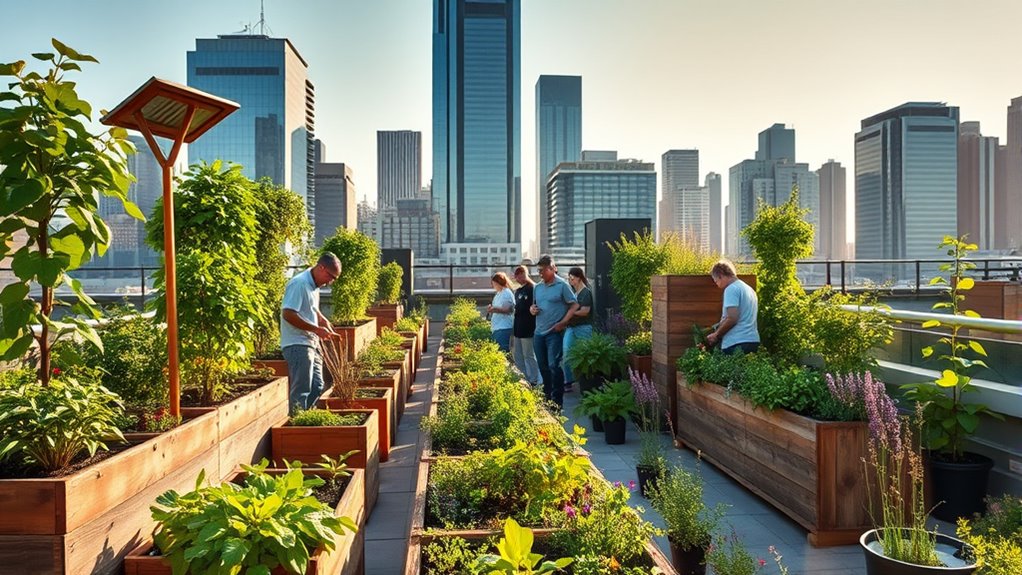
Designing a green, community-focused city garden transforms small urban spaces into vibrant, functional environments that foster connection and sustainability. You can enhance urban gardening by including multi-use elements like seating, planters, and art to boost both aesthetics and utility. Use reclaimed materials such as repurposed containers and locally sourced wood to support sustainable design. Incorporating layered planting strategies, including vertical gardens and ground covers, helps increase urban biodiversity and habitat diversity. Foster community participation through shared compost bins and rainwater harvesting systems, encouraging collaboration and resource efficiency. Additionally, choosing self-watering plant pots can simplify plant care and maintain consistent soil moisture, making gardening more accessible for city dwellers. Carefully plan pathways, privacy screens, and designated zones to create a welcoming, secure environment.
Frequently Asked Questions
How Do You Create a Sustainable Community Garden?
To create a sustainable community garden, you start by involving community members in planning to guarantee diverse plant choices and shared responsibilities.
Use eco-friendly practices like composting, rainwater harvesting, and recycled materials.
Maximize space with vertical gardening and crop rotation.
Educate everyone on pest management and water conservation.
Partner with local organizations for support, funding, and long-term maintenance to keep your garden thriving and sustainable.
How Can Urban Gardening Help in Attaining Sustainability?
Think of your urban garden as a small green heartbeat in the city. It helps attain sustainability by reducing your carbon footprint through local food production, cutting transportation emissions.
You create habitats for pollinators, combat the urban heat island, and conserve water with rain harvesting and mulching.
Growing native plants supports ecological balance, making your city more resilient and greener, one plant at a time.
How to Grow Plants in a City?
To grow plants in a city, start with container gardening using pots or balcony planters to maximize space.
Choose shade-tolerant plants like herbs or lettuce suited for indoor or limited light.
Use vertical gardening techniques to save room and harvest rainwater for sustainable watering.
Fill containers with organic soil or compost to promote healthy growth.
With these methods, you’ll efficiently cultivate fresh plants right in your urban environment.
How Can a Community Garden Be Sustained Over Time?
Like the legendary gardens of Babylon, your community garden can thrive long-term by cultivating shared responsibility and adaptability.
Hold regular meetings to keep everyone engaged, assign clear roles, and foster a sense of ownership.
Use composting and rainwater harvesting to reduce reliance on external resources.
Secure ongoing funding through grants or sponsorships, and partner with local organizations.
A flexible plan that evolves with seasons and input guarantees your garden remains vibrant and sustainable over time.
Conclusion
By embracing these sustainable gardening practices, you turn your city space into a vibrant oasis—a patchwork quilt woven with green hope and life. Every plant you nurture, every drop of water saved, and each natural pest control method you adopt adds a brushstroke to this living masterpiece. Remember, your garden isn’t just a patch of earth; it’s a heartbeat of the city, pulsing with sustainability and community spirit. Grow with purpose, and watch your urban oasis flourish.
